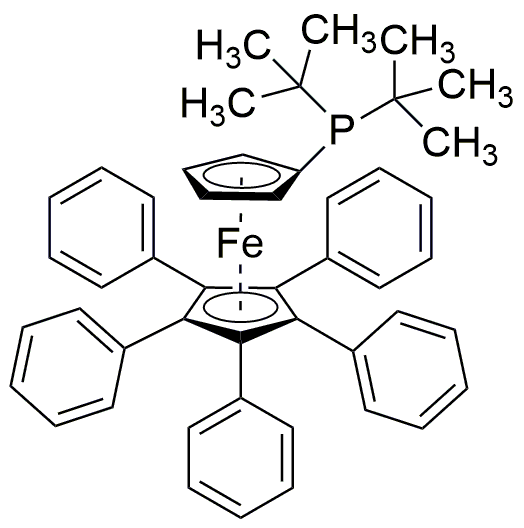1,2,3,4,5-Pentaphenyl-1'-(di-tert-butylphosphino)ferrocene is widely utilized in research focused on:
- Catalysis: This compound serves as a highly effective ligand in various catalytic processes, enhancing reaction rates and selectivity in organic synthesis.
- Material Science: Its unique structure contributes to the development of advanced materials, particularly in the creation of conductive polymers and nanocomposites.
- Pharmaceutical Development: The compound is explored for its potential in drug design, particularly in targeting specific biological pathways due to its ability to form stable complexes with metal ions.
- Electrochemistry: It is used in electrochemical applications, including sensors and batteries, where its redox properties can improve performance and efficiency.
- Research in Organometallic Chemistry: This compound is a valuable tool for studying the behavior of organometallic complexes, providing insights into bonding and reactivity that can inform the design of new compounds.
General Information
Properties
Safety and Regulations
Applications
1,2,3,4,5-Pentaphenyl-1'-(di-tert-butylphosphino)ferrocene is widely utilized in research focused on:
- Catalysis: This compound serves as a highly effective ligand in various catalytic processes, enhancing reaction rates and selectivity in organic synthesis.
- Material Science: Its unique structure contributes to the development of advanced materials, particularly in the creation of conductive polymers and nanocomposites.
- Pharmaceutical Development: The compound is explored for its potential in drug design, particularly in targeting specific biological pathways due to its ability to form stable complexes with metal ions.
- Electrochemistry: It is used in electrochemical applications, including sensors and batteries, where its redox properties can improve performance and efficiency.
- Research in Organometallic Chemistry: This compound is a valuable tool for studying the behavior of organometallic complexes, providing insights into bonding and reactivity that can inform the design of new compounds.
Documents
Safety Data Sheets (SDS)
The SDS provides comprehensive safety information on handling, storage, and disposal of the product.
Product Specification (PS)
The PS provides a comprehensive breakdown of the product’s properties, including chemical composition, physical state, purity, and storage requirements. It also details acceptable quality ranges and the product's intended applications.
Certificates of Analysis (COA)
Search for Certificates of Analysis (COA) by entering the products Lot Number. Lot and Batch Numbers can be found on a product’s label following the words ‘Lot’ or ‘Batch’.
Número de catálogo
Número de lote/lote
Certificates Of Origin (COO)
This COO confirms the country where the product was manufactured, and also details the materials and components used in it and whether it is derived from natural, synthetic, or other specific sources. This certificate may be required for customs, trade, and regulatory compliance.
Número de catálogo
Número de lote/lote
Safety Data Sheets (SDS)
The SDS provides comprehensive safety information on handling, storage, and disposal of the product.
DownloadProduct Specification (PS)
The PS provides a comprehensive breakdown of the product’s properties, including chemical composition, physical state, purity, and storage requirements. It also details acceptable quality ranges and the product's intended applications.
DownloadCertificates of Analysis (COA)
Search for Certificates of Analysis (COA) by entering the products Lot Number. Lot and Batch Numbers can be found on a product’s label following the words ‘Lot’ or ‘Batch’.
Número de catálogo
Número de lote/lote
Certificates Of Origin (COO)
This COO confirms the country where the product was manufactured, and also details the materials and components used in it and whether it is derived from natural, synthetic, or other specific sources. This certificate may be required for customs, trade, and regulatory compliance.


